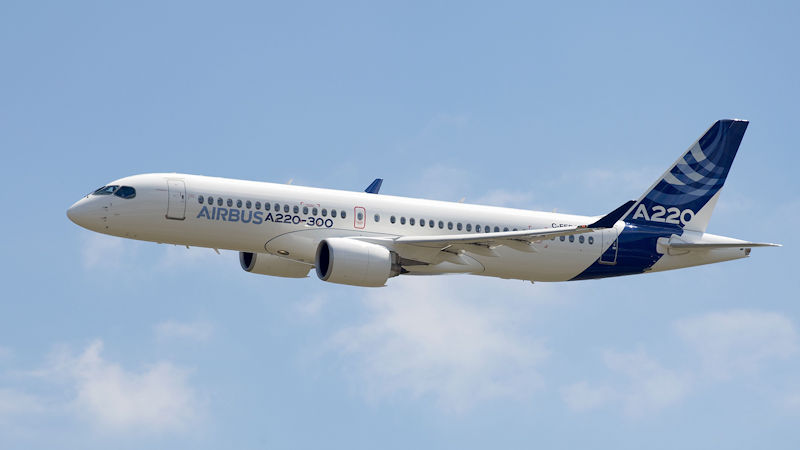
Despite the anxiety caused by the technological innovation that led to the accidents involving Boeing B737 MAX8, major aircraft manufacturing company, Airbus, said technology advancement in aircraft manufacturing is inevitable. But aircraft must be made safer.
When THISDAY asked the CEO of Airbus, Guillaume Faury, would the company slow down new technology in its aircraft, considering the fact that the introduction of Maneuvering Characteristics Augmentation System (MCAS) in Boeing’s B737 MAX 8 had led to two tragic accidents that involved the death of 346 persons, the CEO said that advancing technology in the building of aircraft by Airbus has become inevitable, but in every step of the way time is devoted to ensure that every advancement made is safe.
The CEO was fielding questions from journalists who attended the Airbus Innovation Days 2019 in Toulouse, during a dinner on the first day of the event and noted that Airbus developed fly by wire (FBW) technology, which is a system that replaces the conventional manual flight controls of an aircraft with an electronic interface. In other words, Airbus would continue to introduce technology in flying, which takes more responsibility from the pilot, considering the fact that about 75 per cent of air accidents is caused by human error. But as part of safety check, as technology is introduced, it would be accompanied by redundancies, which could serve as a safeguards against malfunction of the system. This is because technology also has its weakness.
One major example is the Boeing B737 MAX tragic accidents and there have been major incidents when pilots lost control of computers, which became masters of themselves, giving conflicting signals and actions against the wishes of the pilots in control. It has been noted by aircraft engineers that even in fly by wire technology, the failure of electrical systems such as short circuits, system overload could lead to system shutdown.

Airbus Innovation Technology and Safety
In a co-presentation done by Airbus Chief Commercial Officer, Christian Scherer, Executive Vice-President, Programmes and Services, Philippe Mhun and Head of Service, Airbus, Remi Maillard, the company said it is developing technology that would make it easier to manufacturer aircraft.
“We need to have aircraft, which are easier to manufacture. There is a growth of the global market, on the other hand the environment and pressure is pushing us down. There is really the constraint we have to face for this new aircraft and the new aircraft is for tomorrow. But the question is what is this new aircraft? Clearly, the global trend behind that is that whatever we do, we must have an aircraft, which is easier to manufacture. That is the next aircraft number one. The second point is that whichever technology we develop, has value when it allows us develop an aircraft, which is sustainable in all its dimensions, from the design of materials, carbon emissions on the environment at large; and, it has to be more automated,” said Scherer.
The company said that the new aircraft would have to be more automated and more connected.
“It has to be safe. When it is safe, thereafter it has to be safer. I think that is a fundamental point that is the value number one; that is the marker of all growth-safety. This industry has grown over the years and decades by making air transport safer. And that is the journey we have to continue on, whichever instruction, whichever new technology we make, safety is our key priority. All of us; and that is not only an Airbus story, it is a global question,” he said.
Aircraft Manufacturing
Scherer noted that the challenge in aircraft manufacturing still exists but today’s aircraft manufacture involves aerodynamics to stress deterioration, which means that initially the engineers compute the aerodynamic performance of an aircraft that creates loads for the overall aircraft. This makes development faster; enhanced by quantum computing, which would make the manufacturing easier.
Maillard explained that Airbus is working on new materials for the manufacturing aircraft, noting that the company is developing materials from Algae fibres with the ambition to turn this into structural materials with the ultimate goal one day to replace possibly carbon fibres.
“This is one example, something even a bit more visionary than synthetic fibre silk,” she said.
Such materials, she explained, enables significant weight savings and as such reduction of fuel consumption and emissions as a consequence.
“So we at Airbus are very active on a broad area of development and research project. This is incredible fibres developed in a laboratory with a stronger steel, with the toughness beyond the ones that exist, with incredible flexibility properties, giving us the opportunity to genetically tailor their properties with no whatsoever oil needed during the manufacturing process. So it’s a very, very interesting development potential,” she said.
Energy and Fuel Saving
Airbus said it is also working on how to reduce the energy need to power modern aircraft and has continued to work on further reducing fuel consumption. This is aimed at making aircraft lighter and also more functional.
In an aircraft, you need power, which is what is required to fly the aircraft. There is power available, provided by the engine. Definitely we can work and make even bigger engines but at the end of the day, we make heavier aircraft to carry bigger engines, and that is a kind of a vicious circle. Or you turn the wheel the other way round, which is decrease the required power onboard. There are viable solutions for that.
“If we want to target a significant fuel savings and emission reduction, we are going to be going for more breakthrough type of technologies. So, with the long-term ambition to go for zero emission aviation, on the way to achieving that ambitious target, certainly electrical and hybrid proportion will play a major role,” Maillard explained.
Airbus said that it is taking a major leap in technology innovation, which is going to advance the aircraft manufacturing industry. Such development would mark a natural transition in the progress of aircraft manufacturing. This, the company said, is one of the significant changes it intends to bring to the aerospace in terms of operating system, which is to change the type of energy and fuel used in aircraft.
“This is not the type of change that the big aerospace industry, like Airbus will run alone. It will have to be combined in collaboration with major airlines, with airports or sometimes with energy companies like oil and gas companies. But before we get there, as we say in our language, we must have an aircraft. So the point is about getting these technologies and aircraft. And we must find solutions, which as I have said before, onboard the new technologies but also potentially optimise the way we fly,” Maillard said.
Air Traffic Management
Airbus noted that air traffic management has become a challenge in airspace with heavy traffic like in Europe, which causes delays both in the air and on the ground. This leads to more fuel consumption and flight delays. So Airbus is looking at developing a system that could ease the flow in air traffic management.
“The aircraft is not the only part of the issue; we have traffic congestion being an issue of an airline traffic management. That is about the air traffic management systems, it is about the link of the aircraft to the air traffic management. You could say, so what, that is a matter between an aircraft and the ground. In terms of sustainability I think we have one of the most fundamental issues here. We all know the number of delayed flights we have over Europe. Next is the time spent or wasted by aircraft circling over Europe while waiting for the coast to be cleared because their plan was not anticipated enough, so they flew in and then they orbit around the airports of Europe. There is a technical figure that floats on the amount of fuel wasted because the aircraft are wasting time airborne. So, before we talk about any technology improvement of the aircraft, what if we just improve the way the traffic flow is managed. And that is a joint effort that we have together with the air navigation service providers, together with the industry of air traffic management and aircraft manufacturers,” Maillard said.
Airbus A350
One of the aircraft that has benefitted from Airbus’ new technology is Airbus A350.The A350 is the first Airbus aircraft with both fuselage and wing structures made primarily of carbon fibre reinforced polymer.
According to the company, 70 per cent of the frame of the aircraft is made out of combustive materials and most of that being carbon fibre.
“So you have a lighter airplane, you have a very fuel efficiency and you have lower operation cost. And you have an environmental friendly aircraft but remember it is also assembled in a very eco-friendly environment. The versions 900 of the aircraft has 325 passengers on a standard layout, the stretch version, the 1000 version with a 366 passengers on a standard layout and also the URL version which is physically exactly the same as the 900 version with some slight difference. So all these models all of them are assemble here in that building (in Toulouse),” the company said.
Right now Airbus has close to 265 of them out of the 893 firm orders that have been made by airlines.

The A220
Airbus also introduced its new single aircraft, Airbus A220 and announced that the newest addition to its single-aisle portfolio, would now be offering increased range starting from H2 2020.
The company explained that the A220 aircraft maximum takeoff weight (MTOW*) is now confirmed to increase by 2,268 kg (2.3 metric tonnes). The new MTOW will increase the respective maximum range capabilities to 3,350 nm for the A220-300 and 3,400 nm for the A220-100, some 450 nm more than currently advertised.
“In true Airbus tradition we improve our products constantly. This new MTOW will allow operators to reach markets, which today cannot be served by other small single-aisle aircraft types.
“Since its entry-into-service close to three years ago, the A220 aircraft has already proven that it is meeting or beating its initial performance targets, bringing more flexibility and revenue potential to customers,” said Rob Dewar, Head of Engineering & Customer Support for the A220. “Today, Airbus is reinforcing its confidence in the A220 platform and further enhancing its capabilities to meet upcoming market requirements,” said Christian Scherer, Chief Commercial Officer, Airbus.
This performance increase, he said, is achieved by taking credit of existing structural and systems margins as well as existing fuel volume capacity, adding that this would allow airlines to tap into new routes that were not possible before, connecting key cities in Western Europe with the Middle East or from Southeast Asia to Australia.
The A220 has been purpose built for efficiency. It brings together state-of-the-art aerodynamics, advanced materials and Pratt & Whitney’s latest-generation PW1500G geared turbofan engines to offer at least 20 per cent lower fuel burn per seat compared to previous generation aircraft,” Scherer said.






